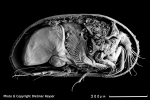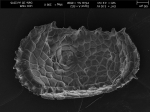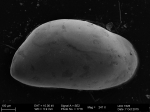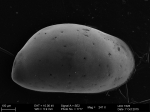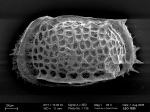
| Intro | | Search taxa | | Bibliography | | Distributions | | Photogallery | | Statistics | | Taxon tree | | Log in |
World Ostracoda DatabaseWhat is an ostracod?Ostracods are amazing small crustaceans, which inhabit virtually all aquatic environments on Earth. The group is characterized by a body completely enclosed between two valves which in many species occur as calcified “shells”. Thus, they have a "seed"-like appearance, and therefore are also known by the term "seed shrimps" or "mussel shrimps". Ostracods range from warm waters of the tropics to very cold environments such polar seas and are found from intertidal zones to many thousands of metres depth in the deep sea They are also adapted to freshwater niches such as rivers, lakes and even temporary ponds. Most species reproduce sexually but some of them reproduce asexually by parthenogenesis.
Ostracods are generally tiny animals, with a body length mostly ranging from 0.2 mm to 2.0 mm. The planktonic genus Gigantocypris can, however, reach 32mm in length. Characteristically ostracods have eight pairs of appendages (though they can be fewer in number), which function mostly in feeding, locomotion and for sensory purposes. Because ostracods have a calcified carapace they have a high preservational capacity. They are by far the most abundant arthropods in the fossil record, occurring in countless numbers at more or less all stratgraphic records from at least the Ordovician onwards. Their soft-parts have even been found in 450 million-year-old rocks. Ostracods have utility: they are used to date and correlate rock sequences world-wide, and are good palaeoenvironmental indicators, revealing information on, for example, palaeobathymetry, palaeosalinity and palaeoclimatic changes of our planet throuph time. Interestingly, ostracods have survived the 5 ‘big extinctions’ of life that have occurred over the last 540 million years, and have also survived in zero gravity for 4 months in the Russian Mir space station! For other interesting facts about ostracods see Williams et al. (2015). The class encloses over 46,000 described species and subspecies (herein), and many more species remain unknown to science. There are two subclasses with living representatives: Myodocopa and Podocopa. The first subclass is exclusive to marine environments, but occupies the benthos as well as the plankton, while podocopans occur in marine, brackish and freshwater environments and occupies almost exclusively benthos (but also the benthopelagic zone). This World Ostracoda Database began as part of the World Register of Marine Species (WoRMS), a global initiative to provide a register of all names of marine organisms living today (or extinct since a geologically short time). But the World Ostracoda Databasealso includes freshwater and fossil taxa. The present database has the following objectives:
Editorial board
New editors are very welcome! Currently, there are 17,275 accepted species in the database, among 24,248 species and 30,841 taxa names. Acceptance is an editorial decision, but we acknowledge that such decisions need to be re-examined frequently in the light of new information. If you disagree with synonymies, generic assignments or higher level systematics, or if you find any omission, mistake, or merely a typo, please send us your argument supported opinion. We intend to update this database frequently, so that your corrections will be incorporated. CitationUsage of data from the World Ostracoda Database in scientific publications should be acknowledged by citing as follows:
LinksThe International Research Group on Ostracoda An Atlas of Southern Ocean Planktonic Ostracods Atlas of Atlantic Planktonic Ostracods Ostracod Research at the Lake Biwa Museum, Japan |

